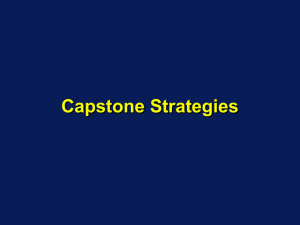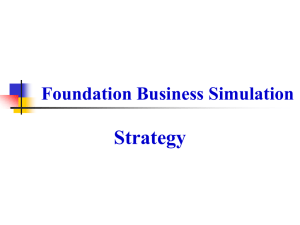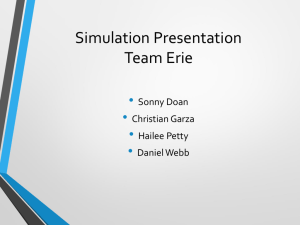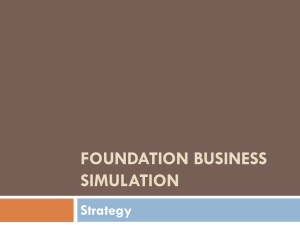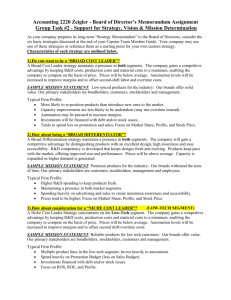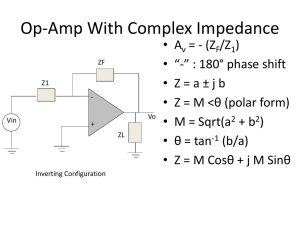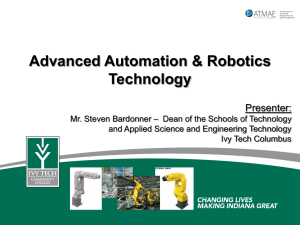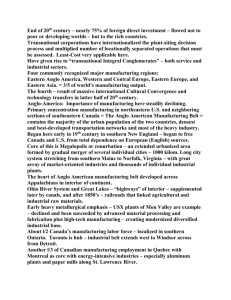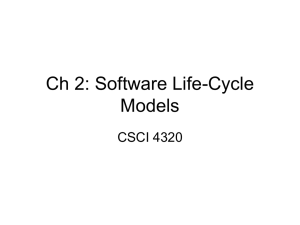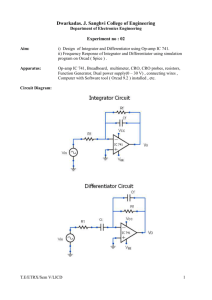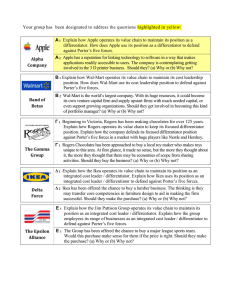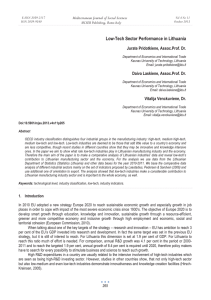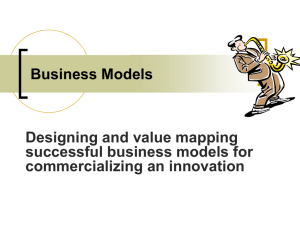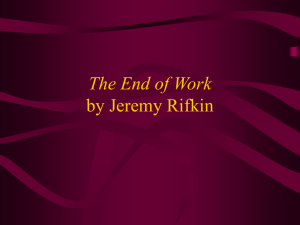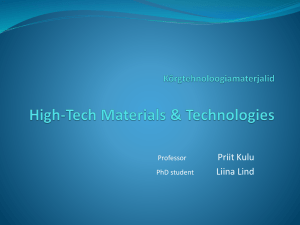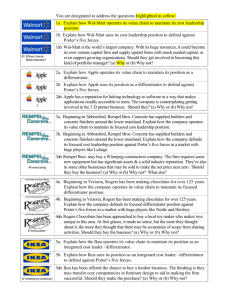Basic Strategies
advertisement
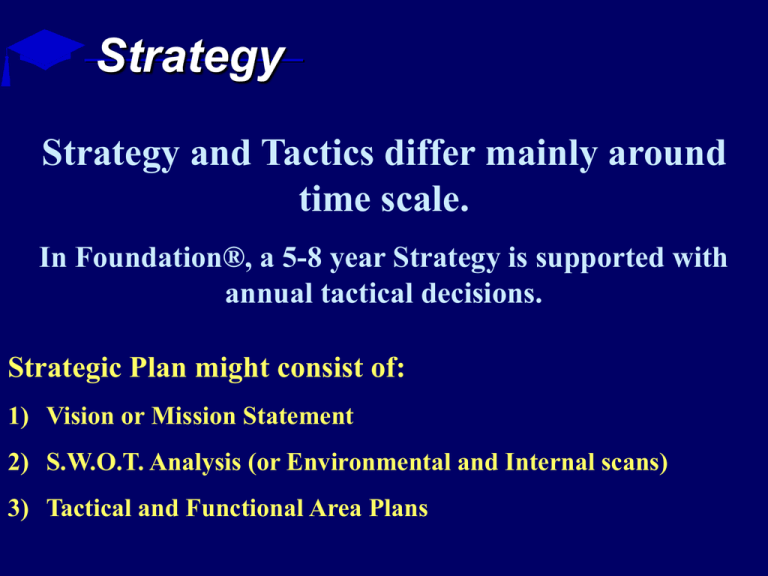
Strategy Strategy and Tactics differ mainly around time scale. In Foundation®, a 5-8 year Strategy is supported with annual tactical decisions. Strategic Plan might consist of: 1) Vision or Mission Statement 2) S.W.O.T. Analysis (or Environmental and Internal scans) 3) Tactical and Functional Area Plans Introduction A strategy is one of four organizational time drivers. Mission Statement (timeless) Strategy (3-5 years) Operational Intents (1 year) Tactics (Day to day) TIME IN YEARS CAPSTONE STRATEGIES STRATEGY Mission Statement PERFORMANCE ASSESSMENT Success Measurements Analyst Report Round Analysis - Star Summary Strategies are declared in corporate mission statements Foundation firms may develop and execute any INDUSTRY AND MARKET ANALYSIS strategy (or none at all S.W.O.T Analysis though that isn’t advisable). Competitor Analysis Competitive Analysis Basic strategies include: Overall Cost Leader Cost Leader with Focus (Low Tech or Product FUNCTIONAL PLANNING Life-Cycle) R&D Differentiator Marketing Production Differentiator with Focus HR Finance (High-Tech or Product TQM Life-Cycle) BUSINESS STRATEGY CONCEPTS Strategy is the comprehensive plan that states how a corporation will achieve its mission and objectives Many different theories on strategies This game uses theories of Michael Porter BASIC CONCEPTS Product life cycle Concept of how a product moves through four stages of “life” Introduction Growth Maturity Decline For game, it reflects a product moving through perceptual map Niche market focused part of a market - limited and clearly defined range of products is sold to specific group of customers An example for the cleaning industry would be a window cleaning service or a cleaning service for people with pets Game allows sales to only low tech or high tech market Competitive advantage Something your firm is perceived to do better than another firm Porter identified two types: Cost advantage – you can deliver similar benefits to consumers at a lower cost than other firms Differentiation – you can deliver benefits that exceed other firms Capstone Strategies The Situation Analysis generated an overview of the forces at work within the Foundation® market place. Now you must decide how to use that information to gain a competitive advantage. There are many different combinations of the basic ideas covered. All can be successful depending on how well they are implemented tactically. BROAD COST LEADER An overall cost leader will attempt to be the low-cost producer in both segments of the market. They will have good profit margins on all sales while keeping prices low. Firm Profile: R&D More likely to revise products than introduce new ones to the market Marketing Prices will be below average Tend to spend less on promotion and sales Production Capacity improvements are unlikely to be undertaken (may run overtime instead) Automation may be pursued to increase margins Finance Investments will be financed primarily with debt NICHE COST LEADER (LOW TECH FOCUS) A low-tech focused cost leader seeks to dominate the low-tech market segment. Their aim is to set prices below all competitors - and still be profitable. Firm Profile: R&D Multiple product lines in the low-tech segment Marketing Spend heavily on promotion (less on Sales as staff has more than one product to pitch to prospects) Prices lower than average Production Invest heavily in automation Finance Investments financed primarily with debt COST LEADER WITH PRODUCT LIFE-CYCLE FOCUS Seek to minimize costs through efficiency and expertise. Products will be allowed to age and change in appeal from high-tech to low end buyers. This saves cost of constant R&D Firm Profile: R&D Marketing Low R&D spending very little re-positioning introduce new product every 2-3 years in High Tech High spending on promotion and sales Production Invest in automation early in the product’s life-cycle Finance Primarily finance with long-term debt BROAD DIFFERENTIATOR A Differentiator will seek to create maximum awareness and brand equity. They want to be well known as makers of high quality/highly desirable products. Firm Profile: R&D High R&D spending to keep products fresh Introduce a new product line to meet need in both markets Marketing Spend heavily on advertising and sales to create maximum awareness and accessibility Prices will be higher (premium product) Production Increase capacity Slight increases in automation if it doesn’t take away from R&D Finance Prefer to finance with stock/operations and avoid debt NICHE DIFFERENTIATOR (HIGH-TECH FOCUS) A high-tech differentiator seeks to be known far and wide as the top producer of the best performing state-of-the-art products. Firm Profile: R&D Multiple product lines in high-tech segment Minimum focus in low-tech segment High R&D expenditures to continually introduce new product lines and keep existing products fresh Marketing High promotion and sales investments to create maximum awareness and accessibility Premium price Production Increase capacity to meet demand Unlikely to invest in increased automation Finance Finance through stock issues and cash DIFFERENTIATOR WITH PRODUCT LIFE-CYCLE FOCUS A product life-cycle differentiator seeks to be wellknown as a top producer of good performing products in each of the targeted segments. Firm Profile: R&D Multiple product lines in both segments High R&D expenditures to continually reposition product lines as they transition from high-tech to low-tech Marketing High promotion and sales investments to create maximum awareness and accessibility Premium price Production Increase capacity Unlikely to invest in increased automation Finance Finance through stock and cash Strategies Evolve Today’s shift is tomorrow’s nightmare • Poor tactics undermine a good strategy • Good tactics can overcome a poor strategy SUMMARY There is no "magic bullet," guaranteed winning strategy. Each simulation has a unique competitive dynamic. Successful firms will focus on planning, strategic alignment, teamwork, competitor analysis, and tactical adjustments. Strategy help available at capsim.com in the Help, Student Resources, Online Managers’ Guide or Tutorials & Demos
